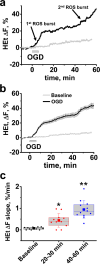Mechanisms of delayed ischemia/reperfusion evoked ROS generation in the hippocampal CA1 zone of adult mouse brain slices
- PMID: 40604107
- PMCID: PMC12222531
- DOI: 10.1038/s41598-025-07070-x
Mechanisms of delayed ischemia/reperfusion evoked ROS generation in the hippocampal CA1 zone of adult mouse brain slices
Abstract
ROS overproduction is an important contributor to delayed ischemia/reperfusion induced neuronal injury, but relevant mechanisms remain poorly understood. We used oxygen-glucose deprivation (OGD)/reperfusion in mouse hippocampal slices to investigate ROS production in the CA1 pyramidal cell layer during and after transient ischemia. OGD evoked a 2-stage increase in ROS production: 1st-an abrupt increase in ROS generation starting during OGD followed by a marked slowing; and 2nd-a sharp ROS burst starting ~ 40 min after reperfusion. We further found that a slight mitochondrial hyperpolarization occurs shortly after OGD termination. Consequently, we showed that administration of low dose FCCP or of FTY720 (both of which cause mild, ~ 10%, mitochondrial depolarization), markedly diminished the delayed ROS burst, suggesting that mitochondrial hyperpolarization contributes to ROS production after reperfusion. Zn2+ chelation after OGD withdrawal also substantially decreased the late surge of ROS generation-in line with our prior studies indicating a critical contribution of Zn2+ entry into mitochondria via the mitochondrial Ca2+ uniporter (MCU) to mitochondrial damage after OGD. Thus, reperfusion-induced mitochondria hyperpolarization and mitochondrial Zn2+ accumulation both contribute to mitochondrial ROS overproduction after ischemia. As these events occur after reperfusion, they may be amenable to therapeutic interventions.
Keywords: Hippocampal slice; MCU; Mitochondria; Mitochondrial hyperpolarization; Oxygen glucose deprivation; Zn2+.
© 2025. The Author(s).
Conflict of interest statement
Declarations. Competing interests: The authors declare no competing interests.
Figures





Update of
-
Mechanisms of delayed ischemia/reperfusion evoked ROS generation in the hippocampal CA1 zone of adult mouse brain slices.Res Sq [Preprint]. 2025 Apr 22:rs.3.rs-5640324. doi: 10.21203/rs.3.rs-5640324/v1. Res Sq. 2025. Update in: Sci Rep. 2025 Jul 2;15(1):23439. doi: 10.1038/s41598-025-07070-x. PMID: 40313775 Free PMC article. Updated. Preprint.
Similar articles
-
Mechanisms of delayed ischemia/reperfusion evoked ROS generation in the hippocampal CA1 zone of adult mouse brain slices.Res Sq [Preprint]. 2025 Apr 22:rs.3.rs-5640324. doi: 10.21203/rs.3.rs-5640324/v1. Res Sq. 2025. Update in: Sci Rep. 2025 Jul 2;15(1):23439. doi: 10.1038/s41598-025-07070-x. PMID: 40313775 Free PMC article. Updated. Preprint.
-
Differential Vulnerability of CA1 versus CA3 Pyramidal Neurons After Ischemia: Possible Relationship to Sources of Zn2+ Accumulation and Its Entry into and Prolonged Effects on Mitochondria.J Neurosci. 2017 Jan 18;37(3):726-737. doi: 10.1523/JNEUROSCI.3270-16.2016. J Neurosci. 2017. PMID: 28100752 Free PMC article.
-
Misprogramming of glucose metabolism impairs recovery of hippocampal slices from neuronal GLT-1 knockout mice and contributes to excitotoxic injury through mitochondrial superoxide production.J Neurochem. 2025 Jan;169(1):e16205. doi: 10.1111/jnc.16205. Epub 2024 Aug 28. J Neurochem. 2025. PMID: 39193789
-
In Vitro Oxygen Glucose Deprivation Model of Ischemic Stroke: A Proteomics-Driven Systems Biological Perspective.Mol Neurobiol. 2022 Apr;59(4):2363-2377. doi: 10.1007/s12035-022-02745-2. Epub 2022 Jan 26. Mol Neurobiol. 2022. PMID: 35080759
-
The Black Book of Psychotropic Dosing and Monitoring.Psychopharmacol Bull. 2024 Jul 8;54(3):8-59. Psychopharmacol Bull. 2024. PMID: 38993656 Free PMC article. Review.
References
-
- Petito, C. K., Feldmann, E., Pulsinelli, W. A. & Plum, F. Delayed hippocampal damage in humans following cardiorespiratory arrest. Neurology37, 1281–1286 (1987). - PubMed
-
- Sugawara, T. & Chan, P. H. Reactive oxygen radicals and pathogenesis of neuronal death after cerebral ischemia. Antioxid. Redox. Signal5, 597–607 (2003). - PubMed
MeSH terms
Substances
Grants and funding
LinkOut - more resources
Full Text Sources
Research Materials
Miscellaneous

